
Concept explainers
Which compound in each pair has the lower
a.  c.
c. 
b.
(a)
Interpretation: The compound in the given pair that has lower
Concept introduction: An acid is the substance that has the ability to donate a proton in the chemical reaction and base is a substance that accepts a proton. The species that do not possess hydrogen ions and formed from an acid are known as the conjugate base. The major factors that contribute to the acidic strength are inductive effect and polarity.
Answer to Problem 19.37P
The compound benzoic acid has lower
Explanation of Solution
The given compounds are,
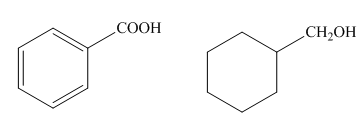
Figure.1
The strength of an acid depends upon the stability of conjugate base. Stable is the conjugate base, higher is the acidity of acid. The anion formed in benzoic acid is resonance stabilized and the negative charge is delocalized on two highly electronegative oxygen atom. Thus, the conjugate base formed by the benzoic acid is more stable than that formed by cyclohexyl methanol. The compounds which have lower
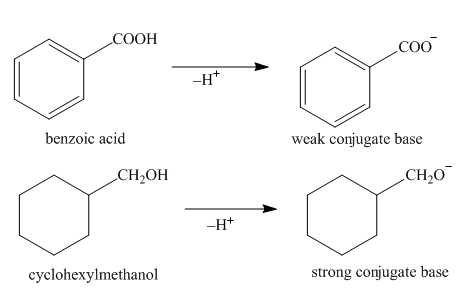
Figure 2
The resonance stabilization of benzoic acid is shown below.
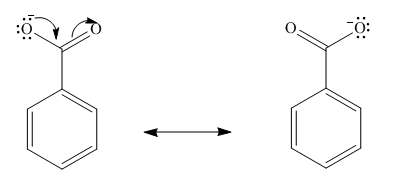
Figure 3
Therefore, the compound benzoic acid has lower
The compound benzoic acid has lower
(b)
Interpretation: The compound in the given pair that has lower
Concept introduction: An acid is the substance that has the ability to donate a proton in the chemical reaction and base is a substance that accepts a proton. The species that do not possess hydrogen ions and formed from an acid are known as the conjugate base. The major factors that contribute to the acidic strength are inductive effect and polarity.
Answer to Problem 19.37P
The compound
Explanation of Solution
The given compounds are
The electron withdrawing groups increase the acidic strength of the compound. Fluorine is more electronegative than chlorine. Due to this, the acidic strength of
The
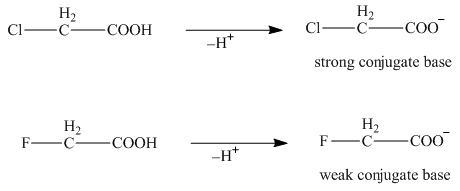
Figure 4
Therefore, the compound
The compound
(c)
Interpretation: The compound in the given pair that has lower
Concept introduction: An acid is the substance that has the ability to donate a proton in the chemical reaction and base is a substance that accepts a proton. The species that do not possess hydrogen ions and formed from an acid are known as the conjugate base. The major factors that contribute to the acidic strength are inductive effect and polarity.
Answer to Problem 19.37P
The compound
Explanation of Solution
The given compounds are shown below.

Figure 5
The electron withdrawing groups increase the acidic strength of the compound. Chlorine is electron withdrawing group, whereas methyl is electron donating group. Due to this, the acidic strength of
The
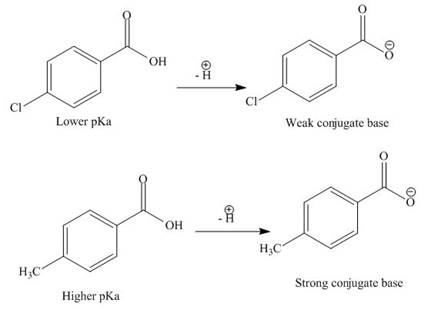
Figure 6
Therefore, the compound
The compound
(d)
Interpretation: The compound in the given pair that has lower
Concept introduction: An acid is the substance that has the ability to donate a proton in the chemical reaction and base is a substance that accepts a proton. The species that do not possess hydrogen ions and formed from an acid are known as conjugate base. The major factors that contribute to the acidic strength are
Answer to Problem 19.37P
The compound
Explanation of Solution
The given compounds are shown below.
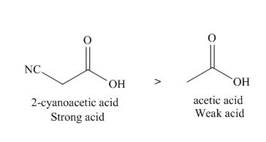
Figure 7
The electron withdrawing groups increase the acidic strength of the compound. Cyano is an electron withdrawing group. Due to this, the acidic strength of
The
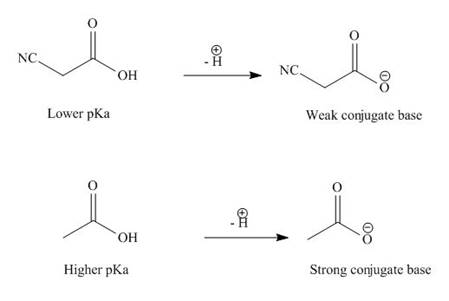
Figure 8
Therefore, the compound
The compound
Want to see more full solutions like this?
Chapter 19 Solutions
Organic Chemistry-Package(Custom)
- Draw the product of the reaction shown below. Ignore inorganic byproducts. + H CH3CH2OH HCI Drawingarrow_forwardplease explain this in simple termsarrow_forwardK Most Reactive Na (3 pts) Can the metal activity series (shown on the right) or a standard reduction potential table explain why potassium metal can be prepared from the reaction of molten KCI and Na metal but sodium metal is not prepared from the reaction of molten NaCl and K metal? Show how (not). Ca Mg Al с Zn Fe Sn Pb H Cu Ag Au Least Reactivearrow_forward
- (2 pts) Why is O2 more stable as a diatomic molecule than S2?arrow_forwardDraw the Lewis structure for the polyatomic phosphite (PO¾³¯) a anion. Be sure to include all resonance structures that satisfy the octet rule. C I A [ ]¯arrow_forwardDecide whether these proposed Lewis structures are reasonable. proposed Lewis structure Is the proposed Lewis structure reasonable? Yes. :0: Cl C C1: 0=0: : 0 : : 0 : H C N No, it has the wrong number of valence electrons. The correct number is: ☐ No, it has the right number of valence electrons but doesn't satisfy the octet rule. The symbols of the problem atoms are:* ☐ Yes. No, it has the wrong number of valence electrons. The correct number is: ☐ No, it has the right number of valence electrons but doesn't satisfy the octet rule. The symbols of the problem atoms are:* Yes. ☐ No, it has the wrong number of valence electrons. The correct number is: ☐ No, it has the right number of valence electrons but doesn't satisfy the octet rule. The symbols of the problem atoms are:* | * If two or more atoms of the same element don't satisfy the octet rule, just enter the chemical symbol as many times as necessary. For example, if two oxygen atoms don't satisfy the octet rule, enter "0,0".arrow_forward
- Draw the Lewis structure for the polyatomic trisulfide anion. Be sure to include all resonance structures that satisfy the octet rule. с [ ] - Garrow_forward1. Calculate the accurate monoisotopic mass (using all 1H, 12C, 14N, 160 and 35CI) for your product using the table in your lab manual. Don't include the Cl, since you should only have [M+H]*. Compare this to the value you see on the LC-MS printout. How much different are they? 2. There are four isotopic peaks for the [M+H]* ion at m/z 240, 241, 242 and 243. For one point of extra credit, explain what each of these is and why they are present. 3. There is a fragment ion at m/z 184. For one point of extra credit, identify this fragment and confirm by calculating the accurate monoisotopic mass. 4. The UV spectrum is also at the bottom of your printout. For one point of extra credit, look up the UV spectrum of bupropion on Google Images and compare to your spectrum. Do they match? Cite your source. 5. For most of you, there will be a second chromatographic peak whose m/z is 74 (to a round number). For one point of extra credit, see if you can identify this molecule as well and confirm by…arrow_forwardPlease draw, not just describe!arrow_forward
- can you draw each step on a piece of a paper please this is very confusing to mearrow_forward> Can the molecule on the right-hand side of this organic reaction be made in good yield from no more than two reactants, in one step, by moderately heating the reactants? esc ? A O O •If your answer is yes, then draw the reactant or reactants in the drawing area below. You can draw the reactants in any arrangement you like. • If your answer is no, check the box under the drawing area instead. olo 18 Ar Explanation Check BB Click and drag to start drawing a structure. 2025 McGraw Hill LLC. All Rights Reserved. Terms of Use | Privacy Center Accessibilityarrow_forwardName the structurearrow_forward
 Organic ChemistryChemistryISBN:9781305580350Author:William H. Brown, Brent L. Iverson, Eric Anslyn, Christopher S. FootePublisher:Cengage Learning
Organic ChemistryChemistryISBN:9781305580350Author:William H. Brown, Brent L. Iverson, Eric Anslyn, Christopher S. FootePublisher:Cengage Learning Chemistry & Chemical ReactivityChemistryISBN:9781337399074Author:John C. Kotz, Paul M. Treichel, John Townsend, David TreichelPublisher:Cengage Learning
Chemistry & Chemical ReactivityChemistryISBN:9781337399074Author:John C. Kotz, Paul M. Treichel, John Townsend, David TreichelPublisher:Cengage Learning Chemistry & Chemical ReactivityChemistryISBN:9781133949640Author:John C. Kotz, Paul M. Treichel, John Townsend, David TreichelPublisher:Cengage Learning
Chemistry & Chemical ReactivityChemistryISBN:9781133949640Author:John C. Kotz, Paul M. Treichel, John Townsend, David TreichelPublisher:Cengage Learning


